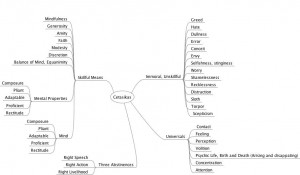I don’t know where this post is going but I have long worked, in my contemplative life, on the concept of Buddhist pyschology. One of the kernels of this is, in my limited understanding the idea of the cittas. The mind produces thoughts like bubbles on a stream. They arise, persist for a while and pass away. But the mental productions are more than just the thoughts that we identify as ego thoughts in Western psychology and metaphysics. They are also the physical, the world, matter, the universe. The whole of the arising and passing away of these mind things, citta, are what is called samsara, the stream of birth and death.
I had come across the concept that citta, the mind “things” arise out of smaller elements. Much like molecules are made of atoms. Many years ago in one of Chogyam Trungpa’s books I had read that these thoughts arise out of five atomic processes, the five universal cetasikas: contact, feeling, perception, volition, attention. Recently I came across the Scribd version of a 1999 book Cetasikas by Nina van Gorkum. While this book is heavily laced with Pali and Sanskrit technical terminology it does provide a more complete explanation of the Cetasikas in English. My interest in these books is not to become a scholar of Pali or Sanskrit but to use the concepts to understand my own mind and to cut through the thought productions to the pure awareness or God consciousness that underlies it all.
So with interest I created a mind map of all of the cetasikas in Nina’s book (click for a larger image):
The problem that I keep coming up with in my meditations is that some thought bubbles reappear. Mostly they are connected with painful past items in my mind, but they re-arise, persist and then dissipate time and time again. I have learned to recognize them: “Ahh, there you are again old friend!” Of course, the way the way to deal with these is pointed out by Kornfield and Goldstein in Insight Meditation is to pay attention to the thought arising, and to leave it alone. Do not attach to it, do not hold onto it, just note it and go back to the breath or the mantra or the contemplation of a phrase from God. But the cetasika show us also a way to hold the thought and look at it. Ask about it in the meditation, what is the doorway of contact, the eye, the ear, the nose, the skin or body, the mind? What is the feeling? Positive, negative, neutral? Away from it toward it? What am I perceiving here? What is wanted here (volition)? IfI direct my attention to various aspects of this mind thing what do I notice? By doing this the hold the mind production has on my monkey mind is lessened, and it can dissipate.
Now with Van Gorkums additions I can see that the cittas come with some thought atomic processes from the immoral, I would prefer to say unskillful, branch of the mind map.
- Greed
- Hate
- Dullness
- Error
- Conceit
- Envy
- Selfishness, stinginess
- Worry
- Shamelessness
- Recklessness
- Distraction
- Sloth
- Torpor
- Skepticism
These are part of the mind molecule, part of the thought. They are not overlays they are atomic processes on their own, arising with the thought, persisting with the thought and dissipating with the thought. Often in Western traditions (and from our mothers!) these are treated as character traits, and faults of the person. In this cetasika light they are part of a formation of the mind, in the person, in the interpersonal, in the transpersonal realms which arises, persists and dissipates. Often I can slip in to self-recrimination at these unskillful thought bubbles: “Why are you thinking about that? Stop!” Perhaps with more practice I can see them differently as Ah, here is greediness, here is dullness… Perhaps is watching it arise, noting its persistance and expecting its dissipation I can become more skillful.
I must admit that I sometimes wondered at the addition of dullness, sloth, and torpor in these unskillful means as they seemed to be more conditions of the body. However, on reflection the body itself is a formation, and these states in the body affect the mind and are affected by the mind. They arise and dissipate. And they are unskillful. It just seems that they are more intractable to change by action of the will. But that is a character of the volition in combination with these elements rather than a statement that these are not mind productions.
Often books and other people will exhort you to use a mind pattern from the skillful side. I think of the floowing from Paul in Philippians:
Finally, brothers and sisters, whatever is true, whatever is noble, whatever is right, whatever is pure, whatever is lovely, whatever is admirable—if anything is excellent or praiseworthy—think about such things.
Philippians 4:7-9
But: how to do that?
The Skillful side of the mind map lays out several qualities.
- Mindfulness
- Generosity
- Amity
- Faith
- Modesty
- Discretion
- Balance of Mind, Equanimity
One which I miss here is one which Goldstein talks a lot about, Metta: loving-kindness or compassion.
I noted also that the mind and the mental properties have five quailities

[…] catches up with Buddhism By davidpetraitis, on May 25th, 2012 In my earlier post on Buddhist psychology I noted that the feeling sense is part of the thought process, prior to understanding, integral to […]